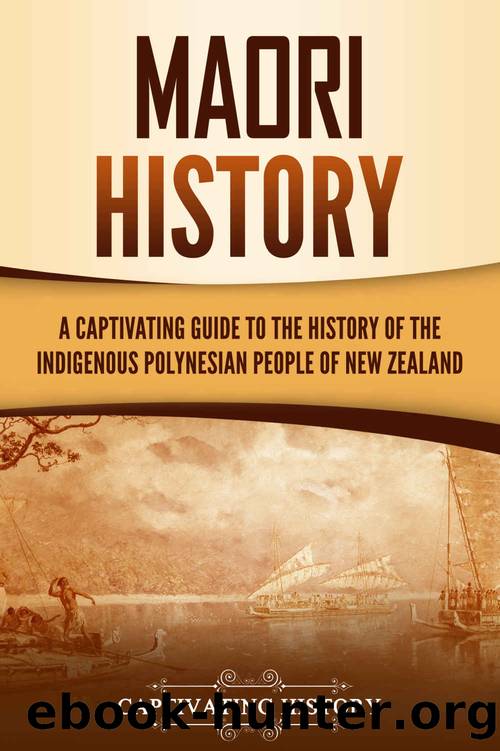MÄori History: A Captivating Guide to the History of the Indigenous Polynesian People of New Zealand by History Captivating

Author:History, Captivating
Language: eng
Format: epub
Published: 2022-02-20T16:00:00+00:00
Picture of TÄmati WÄka Nene taken in the 1870s (top) and an illustration of Te Ruki Kawiti from the 1940s. Source: https://commons.wikimedia.org.
Among the loudest was HÅri KÄ«ngi Te Wharerahi, Mokaâs and Rawaâs third brother, who proclaimed that the governor would bring peace to the MÄori. His speech marked the turning of the tides, and he was helped by another NgÄpuhi chief named TÄmati WÄka Nene, a relative of Hongi Hika. Nene told his fellow chiefs that they had to have sent the PÄkehÄ away when they first arrived. He argued that it was too late now. In fact, they needed a governor to act as a father, peacemaker, and judge among the tribes. However, Nene also declared that the governor had to preserve MÄori land and customs. Both Nene and Wharerahi had considerable mana, and their words carried a lot of weight, allowing the positive stance to slowly take over. Nevertheless, an agreement wasnât reached during the day, and the MÄori discussion continued throughout the night. It was only on the morning of February 6th that the majority of the chiefs accepted the treaty. At that moment, forty-five MÄori chiefs signed their names or, in the case of the illiterate majority, drew their facial moko patterns.
However, before the signing ceremony was carried out, a French Catholic missionary prompted Hobson to tell the MÄori that they wouldnât be persecuted based on their religion. He did this to protect his Catholic followers from the British Protestant government. Hobson agreed, as he just wanted to get the signing over with. Yet, this point was conveyed only vocally. Another missionary spoke to the MÄori in their language, stating that the governor said the âseveral faiths,â including various Christian denominations and âalso MÄori custom,â would be protected by the government. This late verbal addition prompted later scholars to argue that this statement should be considered as the fourth article, one that allowed the freedom of religion. This adds another layer of confusion, leading to much debate among academics. According to some, from the perspective of European legality, the statement only carried moral obligation and weight but was legally unbinding. Others claim that in an oral society such as the MÄori, an unwritten promise had the same weight as the written text.
Yet, in reality, this debate only became important in later periods, when the MÄori struggled against New Zealandâs government for their rights. During the Treaty of Waitangi, it was largely irrelevant to the MÄori chiefs, who once again didnât really understand what the idea behind the freedom of religion was, nor how important it could be. Similarly, other discrepancies between ideas of sovereignty and mana or rangatiratanga, the questions of cultural preservation, and the differences between the English and MÄori versions werenât important at that time. The chiefs only debated about accepting foreign domination, and they based their argument solely on the text presented to them in the MÄori language. All of the debates behind the âtrue meaningâ and issues of legality came later when bilingual scholars educated in the law began inspecting the treaty in its entirety.
Download
This site does not store any files on its server. We only index and link to content provided by other sites. Please contact the content providers to delete copyright contents if any and email us, we'll remove relevant links or contents immediately.
The Memory Code by Lynne Kelly(2288)
Schindler's Ark by Thomas Keneally(1766)
Kings Cross by Louis Nowra(1684)
Burke and Wills: The triumph and tragedy of Australia's most famous explorers by Peter Fitzsimons(1316)
The Falklands War by Martin Middlebrook(1302)
1914 by Paul Ham(1277)
Code Breakers by Craig Collie(1189)
Paradise in Chains by Diana Preston(1183)
Watkin Tench's 1788 by Flannery Tim; Tench Watkin;(1179)
Burke and Wills by Peter FitzSimons(1176)
A Farewell to Ice: A Report from the Arctic by Peter Wadhams(1161)
The Secret Cold War by John Blaxland(1158)
The Protest Years by John Blaxland(1125)
30 Days in Sydney by Peter Carey(1087)
The Lucky Country by Donald Horne(1081)
Lucky 666 by Bob Drury & Tom Clavin(1072)
THE LUMINARIES by Eleanor Catton(1070)
The Land Before Avocado by Richard Glover(1051)
Not Just Black and White by Lesley Williams(1021)
